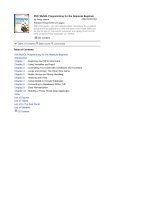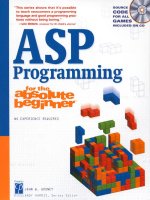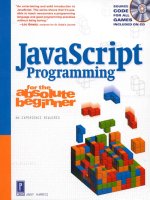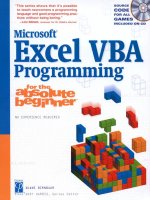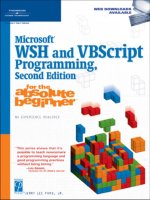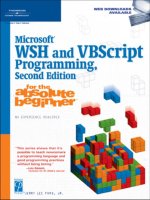JavaScript Programming for the Absolute Beginner ppt
Bạn đang xem bản rút gọn của tài liệu. Xem và tải ngay bản đầy đủ của tài liệu tại đây (8.14 MB, 368 trang )
TEAMFLY
Team-Fly
®
JavaScript
Programming
ANDY HARRIS
© 2001 by Prima Publishing. All rights reserved. No part of this
book may be reproduced or transmitted in any form or by any
means, electronic or mechanical, including photocopying, re-
cording, or by any information storage or retrieval system with-
out written permission from Prima Publishing, except for the
inclusion of brief quotations in a review.
A Division of Prima Publishing
Prima Publishing and colophon are registered trade-
marks of Prima Communications, Inc. PRIMA TECH
is a trademark of Prima Communications, Inc.,
Roseville, California 95661.
Microsoft, Windows, Windows NT, and Internet Explorer are
trademarks or registered trademarks of Microsoft Corporation
in the U.S. and other countries.
Netscape, Netscape Navigator, and JavaScript are trademarks or
registered trademarks of Netscape Communications Corpora-
tion in the U.S. and other countries.
All other trademarks are the property of their respective owners.
Important:
Prima Publishing cannot provide software support.
Please contact the appropriate software manufacturer’s techni-
cal support line or Web site for assistance.
Prima Publishing and the author have attempted throughout this
book to distinguish proprietary trademarks from descriptive terms
by following the capitalization style used by the manufacturer.
Information contained in this book has been obtained by Prima
Publishing from sources believed to be reliable. However, because
of the possibility of human or mechanical error by our sources,
Prima Publishing, or others, the Publisher does not guarantee
the accuracy, adequacy, or completeness of any information and
is not responsible for any errors or omissions or the results ob-
tained from use of such information. Readers should be particu-
larly aware of the fact that the Internet is an ever-changing en-
tity. Some facts might have changed since this book went to press.
ISBN: 0-7615-3410-5
Library of Congress Catalog Card Number: 2001086
Printed in the United States of America
01 02 03 04 05 BB 10 9 8 7 6 5 4 3 2 1
Publisher:
Stacy L. Hiquet
Associate Marketing Manager:
Heather Buzzingham
Managing Editor:
Sandy Doell
Series Editor:
Andy Harris
Acquisitions Editor:
Melody Layne
Project Editors:
Melody Layne and Kim Spilker
Technical Reviewer:
Michael Vine
Copy Editor:
Andrew Saff
Proofreader:
Lorraine Gunter
Interior Layout:
Danielle Foster
Cover Design:
Prima Design Team
Indexer:
Sharon Hilgenberg
Send Us Your Comments:
To comment on this book or any other PRIMA TECH title, visit our reader response
page on the Web at />How to Order:
For information on quantity discounts, contact the publisher: Prima Publishing,
P.O. Box 1260BK, Rocklin, CA 95677-1260; (916) 787-7000. On your letterhead, in-
clude information concerning the intended use of the books and the number of
books you want to purchase.
Untitled-7 4/2/03, 4:28 PM2
To Heather, Elizabeth, and Matthew
Untitled-7 4/2/03, 4:28 PM3
A
c
k
n
o
wl
e
d
g
m
e
nt
s
I
first acknowledge Him from whom all flows.
Thank you again, Heather, for listening to the keyboard clicking all those
late nights. You are the sun and the stars to me.
Thanks to Melody Layne for being a good friend and a good editor (at the same time, even!).
Thank you to Kim Spilker for your encouragement on this project, and to all the folks
at Prima for being nice people to work with.
A special thank you to Andy Saff for copyediting. If this book makes any sense at all, it’s
because of you.
Thank you also to Michael Vine for technical editing. I appreciate your efforts very much.
A very special thank you goes to Scott Porter for his excellent game development library.
His clever programming and selfless generosity make JavaScript game programming
much more accessible than it has ever been before.
I especially want to thank all my students, present and past. You have taught me so
much more than I was ever able to teach you.
Untitled-7 4/2/03, 4:28 PM4
A
b
o
u
t t
he
A
u
t
h
o
r
A
ndy Harris began his teaching career as a high school special education
teacher. During that time, he taught himself enough computing to do part-time
computer consulting and database work. He began teaching computing at
the university level in the late 1980s as a part-time job. Since 1995, he has
been a full-time lecturer in the Computer Science Department of Indiana University/
Purdue University—Indianapolis. He manages the IUPUI Streaming Media Lab for the
department and teaches classes in several programming languages. His main interests
are Java, Visual Basic, Perl, JavaScript/dynamic HTML, virtual reality, programming on
portable devices, and streaming media.
Untitled-7 4/2/03, 4:28 PM5
C
on
t
e
n
t
s a
t
a
G
la
n
c
e
CHAPTER 1Variables, Input, and Output 1
CHAPTER 2 The Fortune Teller:
Random Numbers and the if Statement 21
CHAPTER 3 The Number Guesser: for and while Loops 45
CHAPTER 4 The Basic Mad Lib Program and
Object-Based Programming 63
CHAPTER 5 Advanced Mad Lib: Using
the Other Form Elements 89
CHAPTER 6 Petals around the Rose: Dynamic Output 115
CHAPTER 7Image Swapping and Lookup Tables:
The Basketball Game 139
CHAPTER 8 Dynamic HTML: The Stealth Submarine 171
CHAPTER 9 Sprite Animation: The Racer 203
CHAPTER 10 Using Other gameLib Features:
The Dogfight Game 235
CHAPTER 11 Cookies and the Mouse: The Jigsaw Puzzle 261
CHAPTER 12 The Game Creation Process: The Brick Game 289
A
PPENDIX A Syntax Reference 321
Index 335
Untitled-7 4/2/03, 4:28 PM6
C
on
t
e
n
t
s
Introduction xiii
Variables, Input, and Output 1
The Project: Name Game 2
Adding Code to HTML 3
Using Variables 5
Getting Input from the User 8
Building More Complicated Text 10
Working with Numbers 11
Using String Methods 16
Summary 19
The Fortune Teller:
Random Numbers and
the if Statement 21
The Project: The Fortune Teller 22
Getting Random Numbers 22
Making Specialized Random Numbers 24
Making Decisions with the if Statement 28
Using the else Structure 32
Using Nested if Structures 34
Using the switch Structure 38
Returning to the Fortune Program 42
Summary 44
The Number Guesser:
for and while Loops 45
The Project: The Number Guesser 46
Counting Forward 46
1
CHAPTER
2
CHAPTER
3
CHAPTER
Untitled-7 4/2/03, 4:28 PM7
viii
C
on
t
e
n
t
s
Skipping Values 50
Counting Backward 52
Using the while Loop 53
Returning to the Number Guesser 57
Summary 62
The Basic Mad Lib Program
and Object-Based
Programming 63
The Project: Mad Lib 64
Objects and HTML 65
Reading the Properties of an Object 68
Methods 71
Events 74
The Purpose of Functions 78
Event-Driven Input and Output 79
Back to the Mad Lib Program 84
Summary 88
Advanced Mad Lib:
Using the Other Form Elements 89
The Project: the Advanced Mad Lib 90
Working with Textlike Objects 90
Using Check Boxes 93
Using Radio Buttons 97
Using the select Object 102
Using Multiline Select Boxes 105
Returning to the Advanced Mad Lib Program 107
Summary 114
Petals around the Rose:
Dynamic Output 115
The Project: Petals around the Rose 116
Generating Output in Frames 118
Displaying Output in Separate Windows 122
Designing the Petals around the Rose Game 127
4
CHAPTER
5
CHAPTER
6
CHAPTER
Untitled-7 4/2/03, 4:28 PM8
C
on
t
e
n
t
s
ix
Creating Graphics for JavaScript Games 129
Generating the Dice-Rolling Routine 133
Summary 137
Image Swapping and Lookup
Tables: The Basketball Game 139
The Project: The Basketball Game 140
Swapping Images 141
Using the MouseOver Events 145
Creating Simple Arrays 149
Creating Arrays with Images 152
Using Lookup Tables 155
Putting Together the Basketball Game 160
Summary 168
Dynamic HTML: The Stealth
Submarine 171
The Project: The Stealth Submarine Program 172
Dealing with Browser Dependency 173
Using Cascading Style Sheets 176
Working with Positionable CSS Elements 179
Changing the Text in a Positionable Element 185
Adding Cross-Platform Sound 189
Putting It Together in the Stealth Sub Game 192
Summary 200
Sprite Animation: The Racer 203
The Project: The Racer Program 204
Introducing the Sprite 206
Moving Sprites Around 211
Using Frame Animation in Sprites 214
Detecting Collision 218
Creating a Race Timer 221
Returning to the Racer Program 224
Summary 233
7
CHAPTER
8
CHAPTER
9
CHAPTER
Untitled-7 4/2/03, 4:28 PM9
x
C
on
t
e
n
t
s
Using Other gameLib Features:
The Dogfight Game 235
The Project: The Dogfight Game 236
Using Layers and the Keyboard 237
Adding Sound 242
Improving Sprite Management 244
Adding Missiles 250
Returning to the Dogfight Game 252
Summary 260
Cookies and the Mouse:
The Jigsaw Puzzle 261
The Project: The Jigsaw Puzzle Program 262
Using the Mouse to Drag and Drop 264
Responding to Button Presses 268
Following the Mouse and Sprites 272
Storing Information in Cookies 275
Creating the Jigsaw Game 279
Summary 288
The Game Creation Process:
The Brick Game 289
The Project: The Brick Game 290
Creating the Game Design 290
Setting Up the Playground 292
Adding the Paddle 295
Bouncing the Ball off the Paddle 296
Adding Bricks 298
Adding More Bricks and Sound 301
Adding Multiple Game Boards 304
Changing the Bricks’ Behavior 307
Adding Scorekeeping Functionality 308
Using a Cookie to Track the High Score 318
Improving the Code Used at the End of Game 319
Summary 320
10
CHAPTER
11
CHAPTER
12
CHAPTER
Untitled-7 4/2/03, 4:28 PM10
TEAMFLY
Team-Fly
®
C
on
t
e
n
t
s
xi
Syntax Reference 321
Index 335
A
APPENDIX
Untitled-7 4/2/03, 4:28 PM11
Untitled-7 4/2/03, 4:28 PM12
This page intentionally left blank
I
n
t
ro
d
u
c
t
i
o
n
I
n the early 1980s, my brother and I bought a computer. My mom thought
we were crazy, because it didn’t do anything. She was right. There was very
little software available. We spent many nights typing in programs (usually
games). They almost never worked when we finished typing, so we always
had to look back carefully over the code. Eventually, we were able to fix typographical
mistakes and make the games work. Then, we found ourselves changing the code, so
we could improve the games that we were typing in.
That was a great way to learn how to program. We were working in a simple language
without too many confusing options. We were writing games that were even more fun to
play because we had crafted them ourselves. We were able to combine both logical think-
ing and our creative drives. Game programming was especially rewarding, because the
results were programs that we actually wanted to use. Our skills improved because game
programming provided lots of challenges. We later found that the skills we learned by
developing games were very useful in more “serious” applications as well.
Today it would appear difficult to learn programming in the same way that my brother
and I did. Computers are much more complicated than that old machine that my
brother and I used. Programming languages have become far more complex at the
same time, and the programmer’s toolbox of compilers, integrated environments, and
debuggers seems expensive, complex, and forbidding to somebody who just wants to
get started and play around a little bit.
Still, it is possible to learn to program in almost the same way. A new crop of beginner-
friendly languages is popping up. Specifically, the JavaScript language has emerged as a
new programming language perfect for beginners who want to see what programming
is all about, and who want to learn in a non-threatening but real way. JavaScript is em-
bedded into popular Web browsers, so the language costs nothing. It is available on nearly
every major type of computer system. The language has a reasonably straightforward
syntax that provides beginners a gentle introduction to some important modern con-
cepts, such as object-oriented and event-based programming. It also does not have so
many features that it requires a degree in computer science to understand.
The purpose of this book is to teach you the main principles of programming. You will
learn the major concepts used in most programming languages, and you will apply
them specifically in JavaScript. I will use the context of game programming to teach
the concepts, but you will find that you can use the techniques for purposes far be-
yond game programming. If you already know JavaScript, you will still probably find
some new ideas in the descriptions of game programming. If you have already done
some game development, you might be surprised at the things that you can do with
Untitled-7 4/2/03, 4:28 PM13
xiv
I
n
t
ro
d
u
c
t
i
o
n
JavaScript. If both areas are new to you, you’re going to have a great time exploring
some new things.
Although you will probably not immediately make a million dollars selling computer
games, I think that you will find this book’s approach reasonably friendly. You will
also see that you can easily apply the skills that you learn more generally to other
kinds of more serious programming. Besides, the addition of a game to a Web site can
drastically improve its popularity, making game programming a very practical skill for
any Webmaster.
I am not presuming that you have any programming experience at all. I do expect
that you are comfortable with HTML and that you know how to build Web pages
with a plain text editor. You should have a good text editor, a graphics editor, and a
sound editor. The CD-ROM that accompanies this book has examples of all these pro-
grams. Of course, you will need access to a computer that can run these programs.
You will be running your programs in a Web browser, so you should have access to
recent versions of Netscape Navigator (4.0+) and Internet Explorer (5.0+). Some of the
later examples in this book take advantage of gameLib, a special programming li-
brary. The CD-ROM includes a copy of gameLib. Finally, if you wish to publish your
pages, you will need access to some sort of Web server.
How to Use This Book
To learn how to program a computer, you must acquire a complex progression of skills.
If you have never done any programming at all, you will probably find it easiest to go
through the chapters in order. Of course, if you are already an experienced programmer,
it might not be necessary to do any more than skim the earliest chapters. In either case,
programming is not a skill you can learn by reading. You’ll have to write programs to
learn. This book has been designed to make the process reasonably painless.
Each chapter begins with a complete program that demonstrates some key ideas for
the chapter. Then, you’ll look at a series of smaller programs that illustrate each of the
major points of the chapter. Finally, you’ll put these concepts together to build the
larger program that you saw at the opening of the chapter. You’ll be able to see impor-
tant ideas in simple, straightforward code, and you’ll also see more involved programs
that put multiple ideas together. All the programs are short enough that you can type
them in yourself (which is a great way to look closely at code), but they are also avail-
able on the CD-ROM.
Throughout the book, I’ll throw in a few other tidbits, notably the following:
These are good ideas that experienced
programmers like to pass on.
There are a few areas where it’s easy to
make a mistake. I’ll point them out to you
as you go.
TRAP
HINT
IN THE REAL WORLD
As you examine the games in
this book, I’ll show you how the
concepts are used for purposes
beyond game development.
Untitled-7 4/2/03, 4:29 PM14
I
n
t
ro
d
u
c
t
i
o
n
xv
These will suggest techniques and shortcuts that will make your life as a
programmer easier.
EXERCISES
At the end of each chapter, I’ll suggest some programs that you can write with the skills you’ve
learned so far. This should help you start writing your own programs.
TRICK
Untitled-7 4/2/03, 4:29 PM15
This page intentionally left blank
1
P
rogramming is nothing more than
controlling in a more direct way what
you want your computer to do. You prob-
ably already use a computer in a number of ways,
and you control it to some extent by the programs
you use and the way that you use them. Still, with-
out programming, you are always at the mercy of
the programs designed by others. In this chapter,
you will look at how you can begin to influence the
computer’s behavior. Specifically, you will:
• Examine how you can put code inside a
HyperText Markup Language (HTML) page
• Use dialog boxes to interact with the user
• Learn how computers store data in variables
• Learn how to get data from the user
• Perform basic operations on data
V
ar
i
a
b
l
e
s
, I
n
p
u
t,
a
n
d O
u
t
p
ut
CHAPTER
2
J
a
v
a
S
c
ri
pt
P
r
o
g
r
a
m
mi
n
g
f
o
r t
he
A
b
s
ol
u
t
e B
eg
i
n
n
er
The Project: Name Game
In Figure 1.1, a special box pops up in a normal Web page that asks the user for his or
her name. Then, a series of other boxes pop up, asking for a last name and then finding
other ways to manipulate the name.
FIGURE 1.1
By the end of this
chapter, you will be
able to create this
simple name game.
C
h
a
p
te
r
1V
ar
i
a
b
l
e
s
, I
n
p
u
t, a
n
d O
u
t
p
ut
3
No game publishers will throw money at you after this effort, as the game itself is not
exactly thrilling. However, even this mildly interesting game elevates your Web page
far above the ordinary. Most Web pages do not enable the user to interact with them at
all, so this page immediately stands out as something special, even though what it
does is kind of pointless and silly. Don’t underestimate the power of the Web page
appearing to know your user. It can make the page seem much more personal to the
visitor. You can add this functionality to any Web page you have, and your users will
think you’re really clever.
Adding Code to HTML
Web pages provide a rich background for programming. With the knowledge of HTML
that you already have, you can generate pages that look pretty good. For example, you
can control how text looks and add images. You might even have some experience
with the finer-grained control of cascading style sheets. Still, plain HTML pages lack
true interactivity. The only way that the user can really exert any control over the page
is by clicking on links. This is interesting, but that fun takes the user only so far.
Creating the Hello, World! Application
It would be interesting to make the page a little more dynamic. Both of the major
browsers, Netscape Navigator and Microsoft Internet Explorer, support JavaScript, a
scripting language that is perfect for adding interactive features to a Web page. Take a
look at the following snippet of code:
<html>
<script>
//hello world
//the classic first program
alert("hello world");
</script>
</html>
If you save this code as a Web page, then load that
page into a browser, it generates the screen shown
in Figure 1.2.
This code snippet consists of normal (if very abbre-
viated) HTML, but it uses some features you might
not have seen before. The
<script></script> tag
set specifies to the browser that any code between
the tags is not written in HTML, but in a scripting
language. Both the Netscape Navigator and
Microsoft Internet Explorer browsers use JavaScript,
their default language, unless you specify another
language. (Technically, Microsoft Internet Explorer
runs a variant called Jscript, but the code works
the same as either JavaScript or Jscript.)
You can place script tags anywhere in an HTML
document. All of the code between
<script> and
IN THE REAL WORLD
Although users typically don’t
love things popping up and
interrupting the flow of the pro-
gram, alert boxes are useful for
a number of reasons. First,
they’re very easy to program.
Some of the more graceful ways
of talking to the user require a
little more effort. Second, they
do succeed in getting the user’s
attention. Third, you will find
them an important utility as you
program. For example, you
might often want the program
to pause momentarily and send
you a message about itself as
you are testing it.
4
J
a
v
a
S
c
ri
pt
P
r
o
g
r
a
m
mi
n
g
f
o
r t
he
A
b
s
ol
u
t
e B
eg
i
n
n
er
</script> is written according to the rules of JavaScript. JavaScript is a different lan-
guage than HTML, and its rules are different.
The
// characters denote a comment. The interpreter ignores anything that follows on
a line that begins with these characters. However, the information that programmers
provide in comments is still critical. Comments are mainly for the benefit of the pro-
grammer. It’s a great idea to add lots of comments to your programs, because good
comments can make your code much easier to repair. This particular program has lots
of comments. They explain what the program is intended to do. Such comments are
always a good way to begin documenting your program. You’ll look at some other
useful places to put comments as the code becomes more complex later in this book.
Sending a Message to the User
Only one line of the code fragment does anything particularly interesting:
alert("hello world");
You use the alert statement to send a special kind of message. The message pops up in
its own box, called a
dialog box.
The dialog box is pretty insistent. If you try to click on
the page before you close the dialog box, it will ding at you with a sound, but it will
refuse to do anything else. The box will not close, and the other programs on your
desktop will not receive the focus. It will insist that you respond to it in some way
before you go on to other things in the browser.
You might have noticed the semicolon character (;) at the end of the alert line. This
character indicates the end of the
alert statement. Most lines of JavaScript code end
with the semicolon. The comments did not need a semicolon, because the compiler
ignores them. You’ll see some other places later where a semicolon is not needed at
the end of a line, but for now it’s fine simply to assume that most lines require this
character at the end.
FIGURE 1.2
When the Web page
is loaded into the
browser, a special
box pops up.
TEAMFLY
Team-Fly
®
C
h
a
p
te
r
1V
ar
i
a
b
l
e
s
, I
n
p
u
t, a
n
d O
u
t
p
ut
5
Using Variables
One of the most important aspects of programming to learn is how the computer uses
data.
Data
is defined as the information that the computer collects and manipulates.
In your first few programs, the data will be text, such as names or phrases. Later in this
chapter, you will learn how to use other kinds of data, such as numbers. Programming
languages use something called
variables
as a tool for managing data. In the next
section, you will see how variables are used to store information.
Creating the Hello, Joe! Application
Take a look at the program shown in Figure 1.3. It shows an example of output with
a new twist: This time, the computer generates a message already stored in the
computer’s memory.
This program’s code looks like this:
<html>
<head>
<title>Hello Joe</title>
</head>
<body>
<h1>Hello, Joe</h1>
<script>
//hello Joe
//Demonstrate basic variable concepts
//Andy Harris, 09/00
var greeting;
greeting = "Hi there, Joe";
alert(greeting);
</script>
</body>
</html>
Essentially, this program stores the text “Hi there, Joe,” then displays the message to
the user as soon as the Web page is loaded into the browser. This program illustrates
how the computer can store information for later retrieval. A special kind of element
called a
variable
is the secret.
Computers essentially work with information. It’s important to understand how com-
puters store the information.
Think of it this way: If you carry a lunch to work or school, you probably don’t just grab
a handful of last night’s leftovers and carry them around in your hands until lunch-
time. Instead, you probably use some kind of container, such as a sack. You put the
lunch in the container, which you then carry around until it’s time to eat. You don’t
actually deal with the food until lunch, because it’s easier to work with the container
than the actual food (that is, you would rather carry the sack containing the food than
carry the various items of your lunch individually). Variables fulfill a similar function
for the computer. They hold information until the computer needs to work with it.
6
J
a
v
a
S
c
ri
pt
P
r
o
g
r
a
m
mi
n
g
f
o
r t
he
A
b
s
ol
u
t
e B
eg
i
n
n
er
You’ll learn a lot more about variables later. For now, you simply need to understand
that whenever you want the computer to have some information, such as a user’s name,
a message, or a rate, you’ll need to use a variable.
Using the var Statement
Every computer language provides some kind of support for variables. In JavaScript,
programmers use the
var statement to create a new variable. When you create a vari-
able, you need to give it a name. This is just like putting labels on the food containers
in your refrigerator. When you look at the label, you can see what is inside without
having to open the container. Take another look at this statement, which occurs in the
preceding Hello Joe program:
var greeting;
The term var indicates that the computer should create a variable. The word greeting
is the name that I gave the variable. This line ends with a semicolon, as most lines do.
After interpreting this line of code, the computer generates in memory a chunk of
space named
greeting. Thereafter, you can write code that writes new values to the
memory chunk, and write code that reads the values from the chunk.
Guidelines for Naming Variables
Computer programmers get to name a lot of things. Experienced programmers have
established a few naming conventions. You might want to keep these guidelines in mind:
Be careful about case. In many languages (including JavaScript), username, userName,
and USERNAME are all completely different variable names.
FIGURE 1.3
A greeting to Joe
pops up.
C
h
a
p
te
r
1V
ar
i
a
b
l
e
s
, I
n
p
u
t, a
n
d O
u
t
p
ut
7
Make names descriptive. You probably shouldn’t use a name such as r or x, because
later it will be hard to remember exactly what the variable is supposed to contain.
Names such as taxRate or greeting will make your code much easier to follow.
Don’t use spaces or punctuation. Most languages don’t allow multiword variable names.
Many programmers use capitalization (taxRate) or underscore characters (tax_rate) to
make multiple word variable names easier to read. (I’ll use the capitalization conven-
tion in this book.) Many of the punctuation characters have special meanings, so it’s
not a good idea to put these in a variable name.
Don’t make your variable names so long that they are impossible to type correctly.
Many programmers prefer variable names from 5 to 15 characters long.
Assigning a Value to a Variable
Take a look at this line from the Hello Joe program:
greeting = "Hi there, Joe";
Essentially, this line assigns the text “Hi there, Joe” to the variable greeting. Every-
thing between the quotation marks is called a
string literal.
(Computer programmers
love to give complicated names to simple ideas. Get used to it!)
String
is the term that
computer programmers use for text, because computers handle text as a string of char-
acters.
Literal
means that you are actually specifying the literal value "Hi there, Joe".
The equals sign (
=) indicates assignment. It might make more sense to read this state-
ment as follows:
greeting gets the string literal "Hi there, Joe".
It would not be exactly correct to say that greeting equals "Hi there, Joe".
Equality is an entirely different issue, which I will deal with in the next chapter.
Finally, the word greeting is the name of a variable that gets the string value
"Hi there, Joe".
If you want to give a variable a particular value, you can do so by using a similar assign-
ment statement. Coding a variable assignment statement is like putting leftovers in a
container.
Using the Contents of a Variable
You carry a lunch bag to keep all your food items neatly in one place. If you pull your lunch
bag out of the refrigerator, you are in effect pulling out the entire lunch. In a similar way,
you specify a variable’s name to refer to a variable. Take another look at this line:
alert(greeting);
When the user runs this Web page, he or she does not see the term “greeting” pop up.
Instead, he or she sees “Hi there, Joe,” which is the content of the
greeting variable. It
doesn’t matter what the value of
greeting is, as long as it is some kind of text. This line
of code can output any value stored in the variable
greeting.
TRAP
8
J
a
v
a
S
c
ri
pt
P
r
o
g
r
a
m
mi
n
g
f
o
r t
he
A
b
s
ol
u
t
e B
eg
i
n
n
er
Getting Input from the User
In addition to sending information to the user, computers can also retrieve informa-
tion from the user. This kind of exchange is called
input.
Sometimes people get confused about whether something is input or output. For
example, suppose that you are reading a text message on a computer screen. As
you read the message, you input it to your brain; however, from the computer’s per-
spective, that message is output to the screen. The convention in programming is
that when you talk about either input or output, you are speaking from the point of
view of the computer.
Creating the Hello User! Application
Take a look at this program, which illustrates a simple kind of input:
This time, the computer asks the user his or her name and uses that information in
another statement.
Here’s the code that made this happen:
<html>
<head>
<title>Hello User</title>
</head>
<body>
<h1>Hello, User</h1>
<script>
//hello user
//ask user for name
//Andy Harris, 09/00
var userName;
userName = prompt("What is your name?");
alert(userName);
</script>
</body>
</html>
This program has a variable, but this time a value embedded in the program does not
determine the variable. Instead, the user gets an opportunity to enter a value into a
special dialog box, and the program copies whatever the user types to the variable. Now
that you can get values from the user, you can create programs that are much more
flexible. For example, you can create a program that calls the user by name, even if you
have no idea what that name will be when you write the program (see Figure 1.4).
HINT
